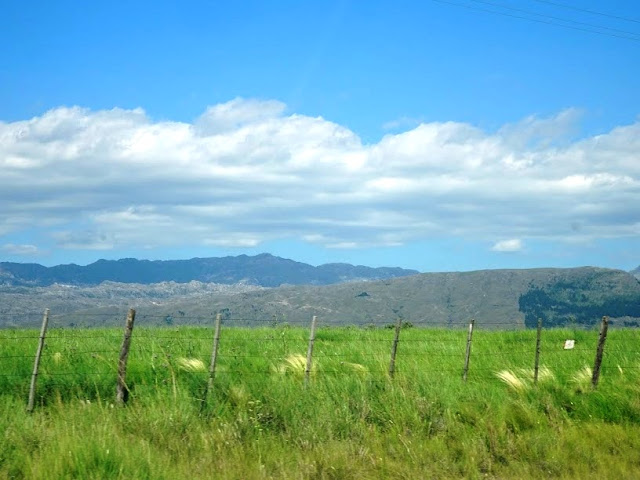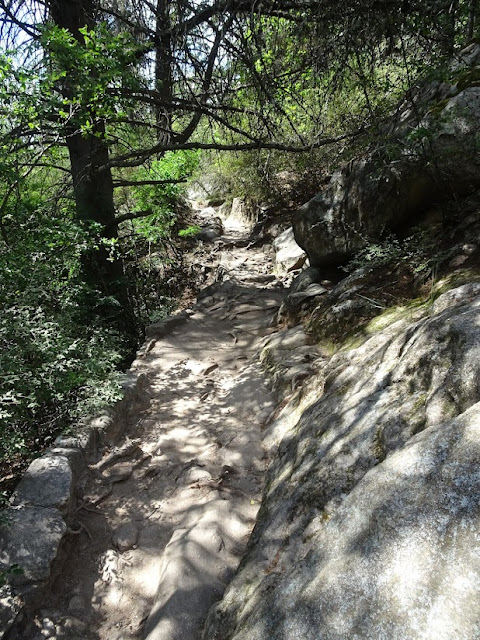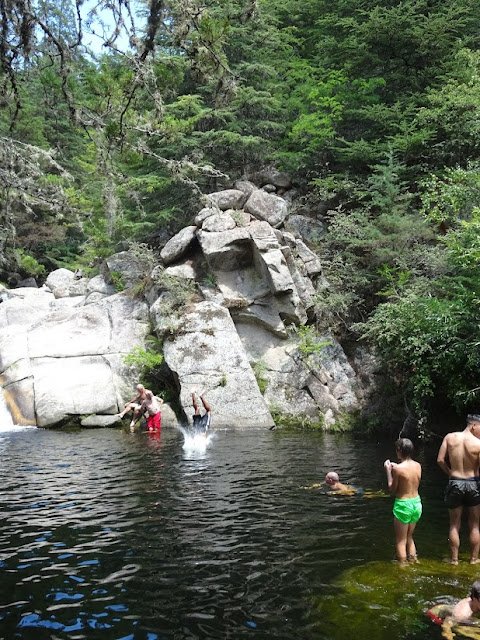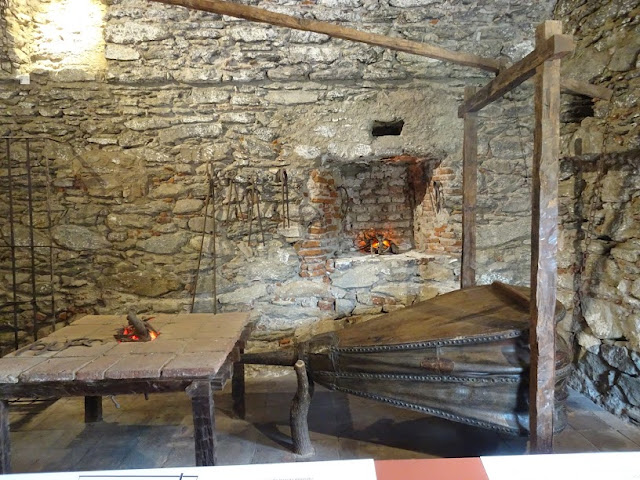Our first stop was Mirador "Altos Del Lago", a view point overlooking the manmade Los Molinos lake, created by a dam on the Los Molinos River, about an hour from Cordoba. The dam was built between 1948-1953 with the primary goal to regulate the flow of the river and the production of hydroelectricty. Like many places in the world, the area is suffering from drought conditions and the level of the lake was quite low. There were still plenty of people out enjoying the water.

After a quick photo stop, we had another hour before we reached La Cumbrecita. It was interesting to see the differences in vegetation. Pines and eucalyptus trees were introduced into the area about 50 years ago and they have become invasive plants. As there are fires, native trees are being replanted in the area.

We left some of the more forested areas and could see the "hills" as Rodrigo called them where we were heading.
 Finally, we arrived at La Cumbrecita, a small village of about 1500 people in the Calamuchita Valley in the Grand Sierras of Cordoba. Dr. Helmut Cabjolsky, from Berlin, Germany was transferred to Buenos Aires in 1932. He and his family missed the mountains from his homeland and they built a summer home in La Cumbrecita. They planted plants and pine trees in this mountain area. Later, the summer house was transformed into a kind of lodging for his friends and it grew so fast that they build another similar hotel. Tourism took off and the architectural style remained German. Now the little, mostly pedestrian, village draws more than 300,000 visitors annually, many who come to visit the waterfalls nature hike.
Finally, we arrived at La Cumbrecita, a small village of about 1500 people in the Calamuchita Valley in the Grand Sierras of Cordoba. Dr. Helmut Cabjolsky, from Berlin, Germany was transferred to Buenos Aires in 1932. He and his family missed the mountains from his homeland and they built a summer home in La Cumbrecita. They planted plants and pine trees in this mountain area. Later, the summer house was transformed into a kind of lodging for his friends and it grew so fast that they build another similar hotel. Tourism took off and the architectural style remained German. Now the little, mostly pedestrian, village draws more than 300,000 visitors annually, many who come to visit the waterfalls nature hike.

We followed the cobbled street up and up the hill before taking a small, steep path to the chapel.

From there, we continued to Cascada Grande on a rocky and tree root covered trail.


About 30 minutes later we arrived at the overlook to the waterfalls. We didn't go down to the water, but there were plenty of people who did and were enjoying the cool water in the 107 degree temperature!

Here is a link to see the falls and people. https://youtube.com/shorts/mN02OO8PJig

We had to follow the same trail down the hill to contine on our hike. We stopped at a few more overlooks and watched folks swimming and diving off the rocks.

We stopped for lunch at one of the restaurants, all of them offering German food choices!
 There were several carvings throughout the town, all in the place where the trees died, so the base of the carvings are still in place.
There were several carvings throughout the town, all in the place where the trees died, so the base of the carvings are still in place.
The original tour was scheduled to go to another "German" town and spend 2-3 hours drinking beer. Our guide suggested going to Alta Gracia and see the Jesuit Estancia and the Che Guevara Museum instead. We agreed!
The town of Alta Gracia was built around the Jesuit estancia (small farm). Erected between 1616 and 1725 by the Jesuits, the purpose of the estancia was to provide economic grounds for the evangelizing works carried out in the region. This was done with three or four Jesuit brothers and over 300 slaves.
In 1767, the Jesuits were expelled from the missions in Argentina and the land was sold at public auction in 1773. Throughout the years, it has been home to not only the Jesuits, but to private families.
We toured around all the rooms and got an idea of how the original inhabitants lived, as well as seeing some of the furniture of the families that lived there.





 In addition to farming the estancia, this location had a large blacksmith shop which produced not only wheel hubs, but locks and hinges.
In addition to farming the estancia, this location had a large blacksmith shop which produced not only wheel hubs, but locks and hinges.


In 2000, UNESCO declared the Jesuit area and the Estancias a World Heritage site.
Our next stop in Alta Gracia was the Che Guevara Museum. It was interesting to learn more about Ernesto "Che" Guevara, who was an Argetine Maxist, revolutionary, physician, author, guerrilla, diplomat, and military theorist. He is very popular with socialists. This museum is in one of the houses he lived with his family when he was young.

It was interesting see see so many documents, photographs, and even a gasoline powered bicycle he rode thousands of kilometers around Argentina and Chile. In 1965, Guevara helped start other revolutions in the Congo and Bolivia. In 1967, he was captured and executed by Bolivian soldiers. His body was not found until 1997.
Che is the boy on the left in the photo below, with his parents and siblings.



After our stop here, we headed back to Corboda, still hot and tired! Our guide took Emi home and we spent the evening relaxing, then going out for dinner.
Che is the boy on the left in the photo below, with his parents and siblings.




After our stop here, we headed back to Corboda, still hot and tired! Our guide took Emi home and we spent the evening relaxing, then going out for dinner.

No comments:
Post a Comment